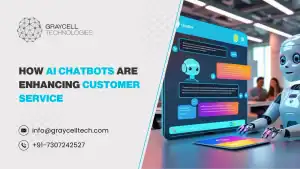“The revenue from the global AI software market is estimated to grow from 10 billion U.S. dollars in 2018 to 126 billion U.S. dollars by 2025.”
From Google’s Gmail spam filter, Netflix’s movie recommendations to Uber’s autonomous vehicles, artificial intelligence, or AI is already dominating our lives on a day-to-day basis. With its unlimited potential, modern-day industries are leveraging this technology to streamline their operations and achieve a higher response value from the target audience. Talking about the software industry, AI applications are used by web designers and web developers to streamline website management tasks on a daily basis and to provide a rich and personalized online experience.
If you are an entrepreneur, you can use AI applications for various purposes: from enhancing the look of your website, strengthening its search abilities, organizing and managing your inventory, targeting consumers through the right digital marketing strategy, offering a personalized user experience to improving interactions with visitors.
AI has quickly become the mainstream technology for the online landscape. It enabled web designers to utilize AI applications into their websites in order to create better functionality and user experience.
AI in UX/UI Design

In the design world, AI is impacting real-life scenarios; however, it does not imply that robots are replacing designers. Techies believe that AI will become an indispensable tool in the user experience designer kit.
It is essential to have a good understanding of artificial intelligence to understand its role in the world of UX/UI.
At present, AI systems are creating a deeper connection between brands and consumers.
Present & Future Role of AI
- AI development has resulted in the development of tools that are used by designers for creating attractive designs in less time. Since AI analyzes data, it helps to easily refine what exactly the user is searching for and refine the product design based on other successful products. It also suggests new design alternatives and how to improve user engagement in the future.
- Personalization is an essential aspect of creating the user experience. With AI, designers are able to build personalized e-commerce websites using buyer’s profile information and other billion data points.
- Designers can design high-performing products by analyzing large volumes of data using artificial intelligence, taking into account the latest standards and conventions, UX design practices, and other usability metrics.
- AI can also help in creating unique variations of landing pages and homepages for news sites, media brands, and much more.
- AI automates the legwork of designers and makes them more efficient in their work. It utilizes AI tools to finish legwork tasks. For instance, Adobe Scene Stitch can identify a pattern in an image and assist designers in editing or patching patterns.
- To create generative visual styles, AI tools are being used. For instance, Prisma. It works on an image recognition technology. This tool identifies the photograph and the best visual effect that can be applied to it
Web Design Diagnostic Tool Using AI

AI is implemented for improving web design functionality and user experience and works as a precision diagnostic tool. Along with modern web design, rapidly changing trends, and stricter search engine standards like Google, the quality of a web design plays a crucial factor in the success of your digital footprint. You may be able to design a high-quality website, you still need to maintain the quality by periodically running tests. Due to the constant repetition of these tests, the source code gets modified and as a consequence, adds further load into the process. Moreover, these tests are time-consuming and take a heavy toll on your website performance.
You can assess the quality of your designs, observe their performance in real-time, and gain real insights on how to refine them using AI-powered analytics tools. AI-based diagnostic tools eliminate the requirement for A/B testing and provide better website design results. As the design software has become increasingly complex, the final product often comes with its challenges.
AI tools and applications can develop and test various information, validate their authenticity, and examine their scope without any human input. The right training of AI can eliminate tons of procedures in building, diagnosing, or editing a design. AI-based testers can also be used to test the visual code of the website, track the web page behavior, and enhance the aesthetics of the page.
Final Thought
Since AI and its integration in the design are in its initial stage, we can expect changes in the coming years. Therefore, designers must know how to make a tradeoff between AI functionality and its design. Although it is difficult to make a balance between the two, designers must ensure to use this technology efficiently. Instead of overwhelming users with a large volume of data, they must focus on creating meaningful patterns.
The next challenge is to translate the developer’s language into the user’s language. It is essential to interpret the developer’s language and communicate it in an easy to understand manner.
You must not directly jump into AI, understand your expectations first, and how AI can fulfill these expectations. Since each day more intelligent systems are being launched, users will expect more capable and efficient products in the coming years.








